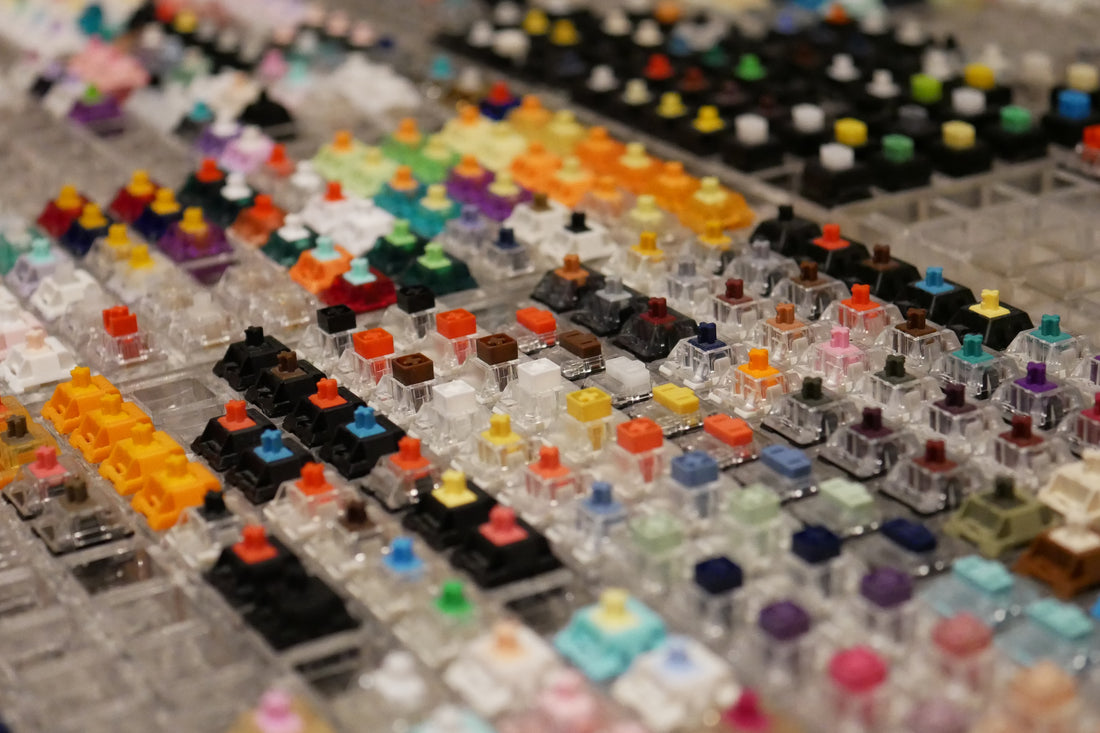
Just How Different Similar Linear Switches Are
Share
“All linears are basically just the same switch as each other.”
Throughout all of my years of collecting and reviewing switches, I’ve lost count on the absolute insane number of (completely wrong) takes people have had about linear switches. Chief among these claims are the ones positing that each and every linear switch out there are so similar that they could be swapped out interchangeably and not make any significant difference. Cherry MX Blacks in place of your Zeal Tealios. Zenclack Oooolongs in place of your Durock Silent Corals. Even your favorite Akko Crystal Silver switches in place of your Gateron Box Ink Pinks. That’s right, there’s “absolutely no real differences” between these switches. Well, in the event that my sarcastic tone throughout this first paragraph didn’t drive home the point clearly enough, I hate to break it to you: there’s a wide variety of different linear switches out there. Just how wide, you ask? Let’s take a look at the subtle and not so subtle differences separating out your favorite linear switches from the rest of the pack!
1. The Obvious Stuff

Figure 1: Trust me, there's many more differences here than you may recognize!
In addition to the skin-deep differences in color and outward appearance that helps distinguish one linear switch from another, there’s quite a few technical differences between linears that aren’t apparent to newcomers to mechanical keyboards. The first and most often discussed technical detail by those interested in switches are the materials and types of plastics that make up each part of the switch. Since not all plastics have the same density, flexibility, or ability to transmit sound, whether a switch is made with nylon versus polycarbonate can have a big difference on how they sound in your keyboard. Take for example the first switch comparison mentioned above in Cherry MX Blacks and Zeal’s Tealios switches. Cherry’s MX Blacks are made entirely with nylon housings which are mechanically thicker than Zeal Tealios’ housings, which are made of polycarbonate. Consequently, the MX Blacks have housing collisions which are deeper, richer, and quieter than the Tealios, which comparatively tend to have clearer, higher pitched, and sharper housing collisions. Other differences between these two switches such as the force it takes to reach the bottom of the downstroke, otherwise known as bottoming out force, can impact just how hard you strike the bottom housing of the switch and the volume of sound emitted as a result. I’ll leave it up to you to guess how the 80-gram spring in Cherry MX Blacks affects their bottoming out sound compared to the mid 60’s gram spring in the Tealios.
2. Bottom Outs
Speaking of bottoming out linear switches, did you ever stop to consider that that point in the switch, in and of itself, has quite a bit of variety? No, I’m not just talking about the differences in heaviness of the springs mentioned in the last article. See, some switches also have different internal structures which can cause the bottoming out location to vary. Take the Zenclack Oooolong mentioned in the second comparison above – because the stem inside of the switch is significantly longer than say something like the Durock Silent Coral, they reach the point of bottoming out quicker. As a result, it feels like these switches only need to be pushed in a fraction of the distance in order to reach the end of a stroke! As well, some switches like the aforementioned Durock Silent Corals also have dampening pads attached to the sides of their stems to reduce the sound of the stem hitting the bottom housing at the end of the stroke. Given that these pads are often made of more flexible and squishy plastics, they deform slowly when pressed into, causing the bottoming out of the Durock Silent Coral to progressively increase in force as opposed to the crash-into-wall feeling on the Zenclack Oooolongs. There’s even springs that can make this curved bottoming out more pronounced in switches without dampening pads too!

Figure 2: Force curve comparison of Zenclack Oooolongs and Durock Silent Corals showing differences in bottoming out location and sharpness.
3. Steepness

Figure 3: Force curve comparison of Gateron Box Ink Pink and Akko Crystal Silver showing differences in the steepness of their downstrokes and upstrokes.
Even if you don’t immediately know how to read a force curve diagram, go ahead and see if you can tell the differences between the force curves for Akko Crystal Silver and Gateron Box Ink Pink switches mentioned as the third comparison at the start of the article. (And in case you want to know more about how to read into the details of these force curves, check out my ‘Basic Guide to Force Curves’ article here!) In addition to some subtle differences in the spring bottoming out weight as well as the bottom out location, you may notice that one of these switches has a ‘steeper’ force curve than the other. Even though almost all linear switches share the characteristic of having a mechanism that leads to a linear increase in force as you push the stem inwards, not all linear switch springs increase their force at the same rate. This phenomenon of ‘steepness’ in linear switches is so rarely discussed in the keyboard community that it’s quite shocking. A switch which adds 10 grams of force every millimeter versus every two or three millimeters, when they only travel a full four millimeters in length, can lead to quite a substantial difference in feeling in hand. While I have no immediate prescription to go about describing this and getting quantitative differences between different linears on such, I still feel compelled to share it because it is perhaps the most different feature between switches that is the least talked about. Honestly, it blew my mind when I had first considered it.

Figure 4: Or maybe I do have some way in mind to describe these differences...?
There you have it! Next time you come across one of those negative karma Reddit users on r/mechanicalkeyboards telling new people that all linear switches are the same, you’re armed with quite a few differences you can throw right back at them. However, just knowing about the existence of these differences isn’t enough – you’ve got to experience them firsthand for yourself. While receiving packages of dozens of new switches in the mail is always exciting when you’re trying to figure out which you’ll use for your next keyboard build, consider that trying out a variety of such also expands your horizons and understanding of all switches quite a bit. Thinking about trying out tactiles instead of linaers, though? How about checking out my article on how I categorize tactile switches!

